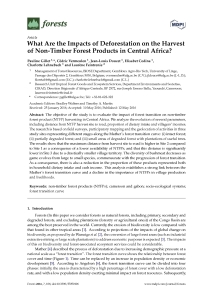Gillet P., Vermeulen C., Doucet J.L., Codina E., Lehnebach C., Feintrenie L.
The objective of the study is to evaluate the impact of forest transition on non-timber forest product (NTFP) harvesting in Central Africa. We analyze the evolution of several parameters, including distance from NTFP harvest site to road, proportion of dietary intake and villagers’ incomes. The research is based on field surveys, participatory mapping and the geolocation of activities in three study sites representing different stages along the Mather’s forest transition curve: (i) intact forest; (ii) partially degraded forest; and (iii) small areas of degraded forest with plantations of useful trees. The results show that the maximum distance from harvest site to road is higher in Site 2 compared to Site 1 as a consequence of a lower availability of NTFPs; and that this distance is significantly lower in Site 3 due to a drastically smaller village territory. The diversity of bushmeat decreases as game evolves from large to small species, commensurate with the progression of forest transition. As a consequence, there is also a reduction in the proportion of these products represented both in household dietary intake and cash income. This analysis establishes a strong link between the Mather’s forest transition curve and a decline in the importance of NTFPs in village production and livelihoods.
Consultez la notice complète de l’article sur ORBi

